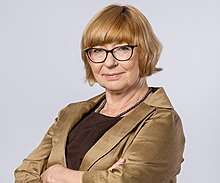Lidia Milka-Wieczorkiewicz
Lidia Anna Milka-Wieczorkiewicz (born 29 May 1956 in Niegoszowice) is a Polish historian and diplomat, ambassador to Algeria (2006–2011) and Tunisia (since 2016).
Lidia Milka-Wieczorkiewicz Ph.D. | |
|---|---|
 | |
| Poland Ambassador to Algeria | |
| In office 2006–2011 | |
| Preceded by | Janusz Mrowiec |
| Succeeded by | Michał Radlicki |
| Poland Ambassador to Tunisia | |
| Assumed office 3 August 2016 | |
| Preceded by | Iwo Byczewski |
| Personal details | |
| Born | May 29, 1956 Niegoszowice, Poland |
| Nationality | Polish |
| Alma mater | University of Warsaw |
| Profession | Diplomat |
Life
Education and academic work
Milka-Wieczorkiewicz was born on 29 May 1956 in Niegoszowice. She finished high school in Dąbrowa Górnicza. Following her studies at the University of Silesia in Katowice, in 1979, she graduated from history at the University of Warsaw.[1] She started academic career there.[2] In 1988, she defended her doctoral thesis on France–Morocco relations. As a scientist, she has been interested in history of Middle East and North Africa countries.[3] She has been carrying out research at the Mohammed V University, Rabat and École des hautes études en sciences sociales, Paris.[4]
Diplomatic career
In 1989 Milka-Wieczorkiewicz joined the diplomatic service. Firstly, she worked as head of consular section at the embassy in Rabat. In 1997 she became Minister-Counsellor at the Africa and Middle East Department at the Ministry of Foreign Affairs. Since 1999 has been serving at the embassy in Beirut, being for more than a year chargé d'affaires there. In 2004 she returned to Poland, became secretary general of the Polish National Commission for UNESCO. Between 2006 and 2011 she was Ambassador to Algeria, accredited to Burkina Faso and Mali as well.[6] On 3 August 2016 she became ambassador to Tunisia.[7][8]
Works
- Droga do niepodległości: polityka Francji wobec Maroka w latach 1944–1953, Warszawa: Wydawnictwa Uniwersytetu Warszawskiego, 1993.
References
- Wituch, Tomasz; Stolarczyk, Bogdan (2010). Studenci Instytutu Historycznego Uniwersytetu Warszawskiego 1945–2000. Kraków: Arkadiusz Wingert. p. 541.
- "Nowa Nauka Polska". nauka-polska.pl (in Polish). Retrieved 2019-06-15.
- Brzeziński, Szymon; Fudalej, Krzysztof (2002). Pracownicy naukowo-dydaktyczni Instytutu Historycznego Uniwersytetu Warszawskiego 1930–2010. Słownik biograficzny. Warszawa: Neriton. p. 82.
- "Ambasador". tunis.msz.gov.pl (in Polish). Retrieved 2019-06-15.
- "Zapis przebiegu posiedzenia Komisji Spraw Zagranicznych /nr 45/". orka.sejm.gov.pl (in Polish). 2006-07-18. Retrieved 2019-06-15.
- "Zapis przebiegu posiedzenia Komisji Spraw Zagranicznych /nr 21/". www.sejm.gov.pl (in Polish). 2016-04-12. Retrieved 2019-06-15.
- webmanagercenter.com; Bessais, Raja (2017-10-10). "L'ambassadeur de Pologne en Tunisie visite la ville de Tozeur". Webmanagercenter (in French). Retrieved 2019-06-18.
- walid. "Le ministre de la Défense reçoit l'ambassadrice de Pologne en Tunisie". Directinfo (in French). Retrieved 2019-06-18.